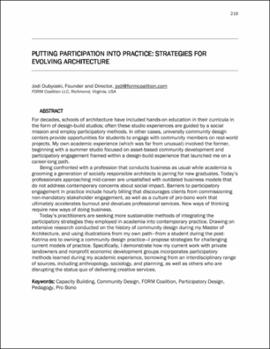| dc.contributor.author | Dubyoski, Jodi | |
| dc.date.accessioned | 2022-03-23T20:44:59Z | |
| dc.date.available | 2022-03-23T20:44:59Z | |
| dc.date.issued | 2022 | |
| dc.identifier.citation | Dubyoski, Jodi, "Putting Participation into Practice: Strategies for Evolving Architecture," in Person, Angela M., Anthony Cricchio, and Stephanie Z. Pilat, eds. 2022. Proceedings of Schools of Thought: Rethinking Architectural Pedagogy, Norman, Oklahoma, March 5-7, 2020. University of Oklahoma Libraries: ShareOK. | |
| dc.identifier.uri | https://hdl.handle.net/11244/335072 | |
| dc.description | This paper was presented at the 2020 Schools of Thought Conference hosted by the Christopher C. Gibbs College of Architecture at the University of Oklahoma. | |
| dc.description.abstract | For decades, schools of architecture have included hands-on education in their curricula in the form of design-build studios; often these studio experiences are guided by a social mission and employ participatory methods. In other cases, university community design centers provide opportunities for students to engage with community members on real-world projects. My own academic experience (which was far from unusual) involved the former, beginning with a summer studio focused on asset-based community development and participatory engagement framed within a design-build experience that launched me on a career-long path. Being confronted with a profession that conducts business as usual while academia is grooming a generation of socially responsible architects is jarring for new graduates . Today’s professionals approaching mid-career are unsatisfied with outdated business models that do not address contemporary concerns about social impact. Barriers to participatory engagement in practice include hourly billing that discourages clients from commissioning non-mandatory stakeholder engagement, as well as a culture of pro-bono work that ultimately accelerates burnout and devalues professional services. New ways of thinking require new ways of doing business. Today’s practitioners are seeking more sustainable methods of integrating the participatory strategies they employed in academia into contemporary practice. Drawing on extensive research conducted on the history of community design during my Master of Architecture, and using illustrations from my own path—from a student during the post-Katrina era to owning a community design practice—I propose strategies for challenging current models of practice. Specifically, I demonstrate how my current work with private landowners and nonprofit economic development groups incorporates participatory methods learned during my academic experience, borrowing from an interdisciplinary range of sources, including anthropology, sociology, and planning, as well as others who are disrupting the status quo of delivering creative services. | |
| dc.language.iso | en_US | |
| dc.relation.ispartof | 2020 Schools of Thought Conference | |
| dc.relation.uri | https://hdl.handle.net/11244/335058 | |
| dc.rights | CC BY-NC-SA | |
| dc.rights.uri | https://creativecommons.org/licenses/by-nc-sa/4.0/ | |
| dc.subject | capacity building | |
| dc.subject | community design | |
| dc.subject | FORM coalition | |
| dc.subject | participatory design | |
| dc.subject | pedagogy | |
| dc.subject | pro bono | |
| dc.title | Putting Participation into Practice: Strategies for Evolving Architecture | |
| dc.type | Article | |
| dc.description.peerreview | Yes | |
| ou.group | Christopher C. Gibbs College of Architecture | |


